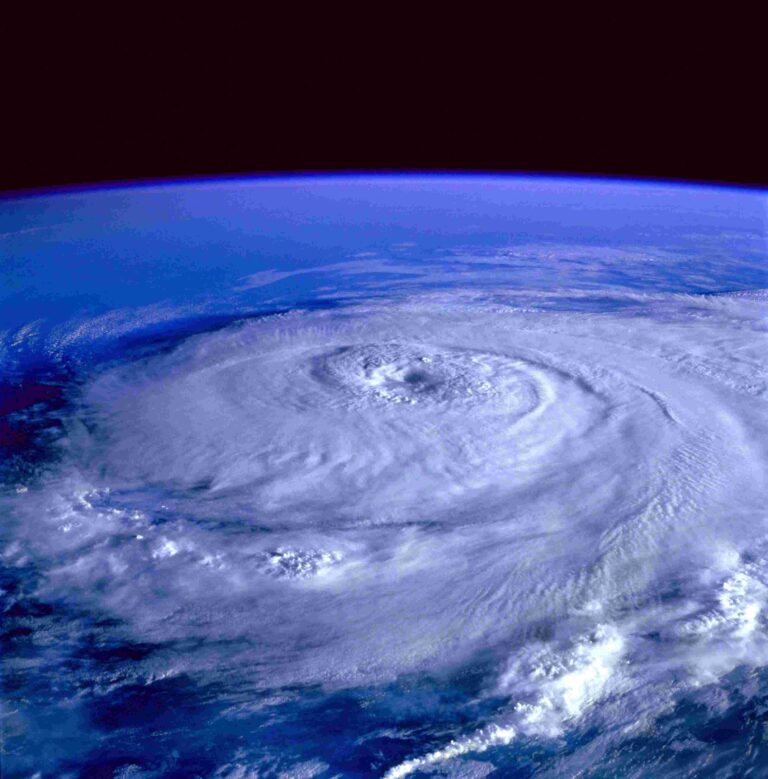
Eye of hurricane from space.
Listen to this Article
One day I decided to change my laundry detergent. Hardly worth a mention, yet it was. The ad for Tru Earth’s zero-waste detergent strips caught my undivided attention and my one-year subscription. Leading up to that moment, I shrank from the task of saving the planet. How could I do my part when I still hoarded plastic bags? What sacrifice was I making when weekly I’d sit in an idling car outside a drive-thru restaurant waiting for my combo? All the while, the space in my laundry closet was steadily shrinking from the plastic jugs and bottles stored and never reused. Assessing these failures, I knew reducing my plastic waste was not just timely, it was doable.

Storm crashing a dock. Photo Credit: George Desipris, Pexel
The use of mahogany (or any other natural resource) invites the discussion of how it’s used and whether the activity surrounding it is sustainable. These questions stem from a growing global focus on environmental responsibility, such that more and more attention is being paid to sustainability as a means of survival for the planet. The idea of sustainability as a way of doing business taps into this desire for survival and so has come to embrace some key elements embodied by CP Woodcraft: environmental consciousness, cultural preservation, social progress, and economic impact.
A Battle Cry
Saving the planet takes real effort, real commitment, and real acceptance of what is no longer sustainable. The real, live-action heroes around us are driving that point all the way to where we live. When world leaders converged for COP27 in Egypt, Barbados Prime Minister Mia Mottley met with the attending youth on day two of the summit, telling them, “The most important thing is I need you guys to read and to become conversant with the issues. Because if you’re not, that is when you’re going to lose the battle.”
Mottley has joined the masses, young and older, taking on the fight of our lives. They’re disrupting the unsustainable world that we built from unfettered profit motive, unaccountable industries, and that invisible hand of market forces led by our insatiable demand.
For example, who knew that the film industry generates a carbon footprint so large it sounds alarms? The cast and crews of these productions did. The founder of Earth Angel, an environmental organization working with international productions to do better, described the outcome for The Guardian, “We obviously construct these massive sets, we shoot in them for a few days sometimes, then we tear them all down – and typically, that’s going into a dumpster.”
Imagine obscene amounts of polystyrene and plastic tossed into landfills. This “industry-wide problem” of generating a massive carbon footprint and producing millions of metric tons of CO2 each year prompted environmental firms and individuals on film production crews to call on governments to better regulate. Some policymakers are listening. Vancouver established a 50% discount on filming permits for productions that forgo diesel generators in favour of those that are battery powered.
Conversations that Birth Campaigns
Then there is the student-led Fossil Free campaign that convinced educational institutions in the UK to stop including fossil fuel extractors in their investment portfolios. In October, Coventry University became the 100th higher-learning institution to announce its divestment of a ₤43.6 million portfolio from all fossil fuel companies.
This is the time we’re in. Conversations to curtail the effects of climate-induced natural disasters have morphed into campaigns that include everything from climate change journalism to divestment pledges to protests and problem-solving blueprints.
My Tru Earth subscription reminded me that I need to be in this battle. Those of us in countries contributing greatly to global heating dare not debate that everything we consume comes at a cost. We can’t afford natural disasters such as the flooding that levelled Pakistan this summer and the second hurricane that devastated Puerto Rico within five years. As I write, a village in El Bosque, Mexico is watching its homes along the eroding southern coast slip into the sea. More than 50 families are expected to be displaced within months.
I don’t need to be living in Mexico to know that we’ve lost the battle if we don’t ask ourselves, What can I do? And when we do start that sustainable, earth-friendly practice, we must describe it out loud.
Saada Branker is a writer and editor living in Toronto.
